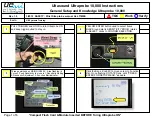
-
2
-
-
3
-
-
4
-
-
1
-
Guide rail
Case
Option board
Front panel
Blank panel
94.8
44.6
120
96
48
(1
39
.1
)
7.
5
45
+0
.6
-0
92
+0.8
-0
MIN. 120
MI
N
. 70
A D- 45 30
HI OK LO
OZ
HOLD
HI
+/-
HOLD
LO
ESC
ZERO
1
3
2
5
4
1
1
2
3
AD-4530
Digital Indicator
Simplified
Instruction Manual
© 2011 A&D Company, Limited. All rights reserved.
No part of this publication may be reproduced, transmitted,
transcribed, or translated into any language in any form by any
means without the written permission of A&D Company, Limited.
The contents of this manual and the specifications of the
instrument covered by this manual are subject to change for
improvement without notice.
This is a simplified instruction manual. For a detailed
instruction manual, refer to A&D’s web site.
URL: http://www.aandd.jp/
1WMPD4002283
1. BEFORE USE
The digital indicator is a precision instrument. Unpack the digital
indicator carefully and confirm that all items are present.
1.1. Precautions Before Use
Avoid water and moisture.
Avoid vibration, shock, extremely high temperature and humidity,
direct sunlight, dust, and air containing salt or sulfurous gases.
Avoid places where inflammable gases or vapors are present.
The operating temperature is -10°C to +40°C.
A 100 VAC to 240 VAC power source is required. Use a stable
power supply free from sudden dropout or noise as they can cause
malfunctions. Avoid sharing the power line.
Keep cables away from power cables and other sources of
electrical noise.
Connect only a non-inductive load of 10 k
Ω
or more to the analog
voltage output terminals.
Connect only a non-inductive load of 510
Ω
or less to the analog
current output terminals.
When connecting long cables to the sensors, keep the cables
away from power cables and other sources of electrical noise
Do not connect the AD-4530 to the power supply before installation
is completed. The AD-4530 has no switch to disconnect the power
supply.
Use shielded load cell cables.
Do not connect too many sensors. Otherwise, instrument damage may
occur.
1.2. Precautions During Use
The AD-4530 is a precision instrument that measures the microvolt
output from sensors. Prevent noise sources such as power lines,
radios, electric welders or motors from affecting the instrument.
Do not try to modify the AD-4530.
In all hold modes, the hold data is saved digitally, so there is no
drooping of the value displayed on the display panel or the analog
output. Note that the hold function is disabled when the AD-4530 is
disconnected from the power supply.
Disconnect from the power supply before removing the cover.
When removing the cover, make sure that the power is off.
Do not touch the instrument immediately after it is disconnected
from the power supply.
To avoid electrical shock, do not touch the internal part of the
instrument within ten seconds after switching the power off.
Be sure to fasten all the screws completely.
Loose screws may come off during operation and a short circuit
may occur or measurement errors may occur due to noise.
2. EXTERNAL DIMENSIONS
Panel cutout dimensions / Separation
*Maintain the intervals above when installing
Unit: mm
3. GENERAL SPECIFICATIONS
Voltage requirement:
100 VAC to 240 VAC +10%, -15% (50/60 Hz)
Power requirement:
Approx. 10 VA
Sensors:
5 volt, 120
Ω
, one sensor maximum
5 volt, 350
Ω
, three sensors maximum
Operating temperature: -10 °C to +40 °C
Operating humidity:
Max. 85% RH (no condensation)
External dimensions:
96 x 48 x 127.5 mm (W x H x D)
Panel cutout:
92 x 45 mm
Separation:
Width: 120 mm or more
Length: 70 mm or more
Weight:
Approx. 290 g
4. OPTIONS
4.1. Options
AD-4530-200: Relay
output
AD-4530-030: RS-485
AD-4530-040: RS-232C
AD-4530-007: Analog
output
AD-4530-237: Relay output, RS-485, analog output
AD-4530-247: Relay output, RS-232C, analog output
Note: Only one option can be installed in the AD-4530 at a time.
4.2. Installing an option
1. Remove the two screws that secure the guide rail, and then remove
the guide rail.
2. Remove the two screws that secure the case.
3. Pull the case out from the front panel (holding it as shown).
4. Remove unnecessary blank panels with nippers, etc.
5. Insert the option board at the position specified on the rear of the front
panel.
6.
Reattach the case and guide rail by reversing the steps above.
5. FRONT PANEL
5.1. Display
Displays a measured or set value. To set the decimal point position, use
function mode
Cf01
. The display is composed of four seven-segment
indicators plus a minus sign.
5.2. Status indicators
Name Description
1
HI
Turns on when the measured value is greater than
the upper limit (HI).
2
OK
Turns on when the measured value is equal to or greater
than the lower limit and equal to or less than the upper
limit.
3
LO
Turns on when the measured value is less than the
lower limit (LO).
4
DZ
Turns on when adjusting the digital zero.
5
HOLD
Turns on when a value is being held.
5.3. Keys
Operation Function
Press to proceed to the upper limit value
setting mode.
When inputting a numerical value, press to
change the polarity.
Press to proceed to the lower limit value
setting mode.
When inputting a numerical value, press to
cancel the setting.
Press to turn the digital zero on.
When inputting a numerical value, press to
shift the position of the blinking digit to the
right or change the function group.
+
Press to turn the digital zero off.
Press to turn holding on or off.
When inputting a numerical value, press to
change the blinking digit or change the
function parameter.
Press to output the serial data (print).
When inputting a numerical value, press to
enter the setting.
+
Press to proceed to calibration mode.
+
Press to proceed to function selection
mode.
+
+
Press to proceed to selection mode in the
check mode.
* The digital zero function sets a desired measurement point as zero and
displays the deviation from this zero point. When measuring a load, it can
be used as the tare, etc.
* The zero value is saved in non-volatile memory (EEPROM). This zero
value is retained even after the power has been turned off and on (or
power is lost).
* To change the digital zero operation, use the function
Cf11
.
To protect against accidental operation, press and to
turn the digital zero on or off.
5.4. Operation mode
- Upper / lower limit setting mode
Use this mode to set the upper and lower limit of the comparator.
- Calibration mode
Use this mode to perform zero and span calibration with an actual load.
- Function setting mode
Use this mode for setting functions.
- Check mode
Use this mode to confirm input and output operation.
6. REAR PANEL
Confirm the terminal numbers when making connections.
When making connections, confirm the terminal
numbers printed on the side of the terminal block and
on the top of the indicator casing.
6.1. Connector function
6.1.1 AC input connector
(1) AC Connect the AC power cord.
(2) AC The power requirement is 100 VAC to 240 VAC, 50/60 Hz.
When making connections,
Switch off the power of all the instruments used
Keep cables away from power cables and other
sources of electrical noise
6.1.2 Load cell / Control input connector
Load cell
(1) SHLD
Connect the shielded cable of the sensor cable.
(2) SIG-
Negative signal input terminal for the sensors.
(3) SIG+
Positive signal input terminal for the sensors.
(4) EXC-
Negative excitation terminal for the sensors.
(5) EXC+
Positive excitation terminal for the sensors.
Control input
(6) COM
Input common terminal.
(7) LATCH Inputs the latching signal for the function settings
and outputs.
(8) HOLD
Inputs the hold signal.
(9) ZERO
Inputs the zero correction signal.
6.1.3 Relay output connector (Option)
(1) COM
Relay output common terminal
(2) LO
Relay LO output terminal
Outputs LO when the measured value is less than the
lower limit.
(3) OK
Relay OK output terminal
Outputs OK when the measured value is equal to or
greater than the lower limit and equal to or less than
the upper limit.
(4) HI
Relay HI output terminal
Outputs HI when the measured value is greater
than the upper limit.
Comparator output
To prevent damage, do not exceed the rated capacities
of the output relays.
To protect the output relays, use a varistor, CR circuits or
diodes.
6.1.4 Serial communication connector (Option)
In the case of RS-232C
(1) IC
Connected internally (Do not use)
(2) IC
Connected internally (Do not use)
(3) SG
Signal ground terminal
(4) TxD
B terminal
(5) RxD
A terminal
In the case of RS-485 (Two-wire connection)
(1) B
B terminal
(2) A
A terminal
(3) SG
Signal ground terminal
(4) B
B terminal
(5) A
A terminal
* Each of the A and B connections has two terminals.
These terminals are connected internally and can be used for a
terminating resistor or multi-drop connection.
6.1.5 Analog output connector (Option)
(1) COM
Common terminal of the analog output
(2) IOUT
Analog current output terminal
(3) VOUT
Analog voltage output terminal
4 3 2 1
5 4 3 2 1
3 2 1
1 2
1 2 3 4 5 6 7 8 9
Relay output
RS-232C
/
RS-485 Analog output
AC
Load cell / Control input
AD-4530
HI OK LO
DZ
HOLD
HI
+/-
HOLD
LO
ESC
ZERO
Display
Keys
1 2 3
4
5
AD-4530
HI OK LO
DZ
HOLD
HI
+/-
HOLD
LO
ESC
ZERO




















